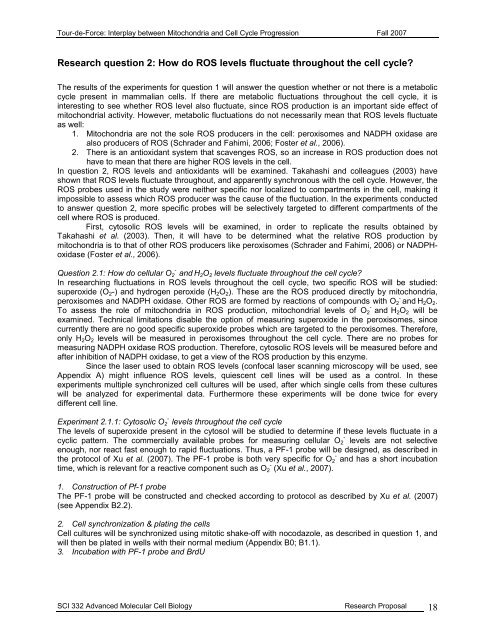Tour-de-Force
Tour-de-Force
Tour-de-Force
Create successful ePaper yourself
Turn your PDF publications into a flip-book with our unique Google optimized e-Paper software.
<strong>Tour</strong>-<strong>de</strong>-<strong>Force</strong>: Interplay between Mitochondria and Cell Cycle Progression Fall 2007Research question 2: How do ROS levels fluctuate throughout the cell cycle?The results of the experiments for question 1 will answer the question whether or not there is a metaboliccycle present in mammalian cells. If there are metabolic fluctuations throughout the cell cycle, it isinteresting to see whether ROS level also fluctuate, since ROS production is an important si<strong>de</strong> effect ofmitochondrial activity. However, metabolic fluctuations do not necessarily mean that ROS levels fluctuateas well:1. Mitochondria are not the sole ROS producers in the cell: peroxisomes and NADPH oxidase arealso producers of ROS (Schra<strong>de</strong>r and Fahimi, 2006; Foster et al., 2006).2. There is an antioxidant system that scavenges ROS, so an increase in ROS production does nothave to mean that there are higher ROS levels in the cell.In question 2, ROS levels and antioxidants will be examined. Takahashi and colleagues (2003) haveshown that ROS levels fluctuate throughout, and apparently synchronous with the cell cycle. However, theROS probes used in the study were neither specific nor localized to compartments in the cell, making itimpossible to assess which ROS producer was the cause of the fluctuation. In the experiments conductedto answer question 2, more specific probes will be selectively targeted to different compartments of thecell where ROS is produced.First, cytosolic ROS levels will be examined, in or<strong>de</strong>r to replicate the results obtained byTakahashi et al. (2003). Then, it will have to be <strong>de</strong>termined what the relative ROS production bymitochondria is to that of other ROS producers like peroxisomes (Schra<strong>de</strong>r and Fahimi, 2006) or NADPHoxidase(Foster et al., 2006).Question 2.1: How do cellular O 2-and H 2 O 2 levels fluctuate throughout the cell cycle?In researching fluctuations in ROS levels throughout the cell cycle, two specific ROS will be studied:superoxi<strong>de</strong> (O 2 -) and hydrogen peroxi<strong>de</strong> (H 2 O 2 ). These are the ROS produced directly by mitochondria,peroxisomes and NADPH oxidase. Other ROS are formed by reactions of compounds with O 2-and H 2 O 2 .To assess the role of mitochondria in ROS production, mitochondrial levels of O 2-and H 2 O 2 will beexamined. Technical limitations disable the option of measuring superoxi<strong>de</strong> in the peroxisomes, sincecurrently there are no good specific superoxi<strong>de</strong> probes which are targeted to the peroxisomes. Therefore,only H 2 O 2 levels will be measured in peroxisomes throughout the cell cycle. There are no probes formeasuring NADPH oxidase ROS production. Therefore, cytosolic ROS levels will be measured before andafter inhibition of NADPH oxidase, to get a view of the ROS production by this enzyme.Since the laser used to obtain ROS levels (confocal laser scanning microscopy will be used, seeAppendix A) might influence ROS levels, quiescent cell lines will be used as a control. In theseexperiments multiple synchronized cell cultures will be used, after which single cells from these cultureswill be analyzed for experimental data. Furthermore these experiments will be done twice for everydifferent cell line.-Experiment 2.1.1: Cytosolic O 2 levels throughout the cell cycleThe levels of superoxi<strong>de</strong> present in the cytosol will be studied to <strong>de</strong>termine if these levels fluctuate in a-cyclic pattern. The commercially available probes for measuring cellular O 2 levels are not selectiveenough, nor react fast enough to rapid fluctuations. Thus, a PF-1 probe will be <strong>de</strong>signed, as <strong>de</strong>scribed inthe protocol of Xu et al. (2007). The PF-1 probe is both very specific for O - 2 and has a short incubationtime, which is relevant for a reactive component such as O - 2 (Xu et al., 2007).1. Construction of Pf-1 probeThe PF-1 probe will be constructed and checked according to protocol as <strong>de</strong>scribed by Xu et al. (2007)(see Appendix B2.2).2. Cell synchronization & plating the cellsCell cultures will be synchronized using mitotic shake-off with nocodazole, as <strong>de</strong>scribed in question 1, andwill then be plated in wells with their normal medium (Appendix B0; B1.1).3. Incubation with PF-1 probe and BrdUSCI 332 Advanced Molecular Cell Biology Research Proposal 18
















